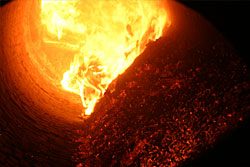The Process – Incineration
Photographic paper and film as well as other suitable combustible silver containing materials are incinerated in a 1.3 metre diameter refractory lined rotary kiln incinerator. The kiln combustion conditions are maintained by instrumentation and control systems, with operational data logging and retrieval by an on-line computer.
Material is charged into a static primary combustion chamber, where material is ignited, before moving into the rotating kiln. Combustion air is drawn into the ash discharge end of the kiln, flowing counter-current to the burning material, and is drawn through into the primary chamber.
Material and ash move along the kiln by a combination of the rotation and the inclination of the kiln. Ash is discharged from the end of the kiln. The counter-current airflow ensures that ash is well burned and cool before discharge.
Combustion is sustained by the calorific value of the raw material. No fuel is used. Wet materials can be dried and calcined by directly using the waste heat generated within the combustion process.
The exhaust gases are drawn through a high temperature afterburn system and eventually quenched by water spray for temperature control. Lime and activated carbon are injected into the raw gas stream to aid the absorption of acid gases and dioxins. The exhaust gases are cleaned by a dry filter plant, before discharge to atmosphere through a 35 metre exhaust stack.
Particulate emissions to atmosphere are continuously monitored with routine gas and metal emissions monitoring conducted as required by our environmental operating permit.




